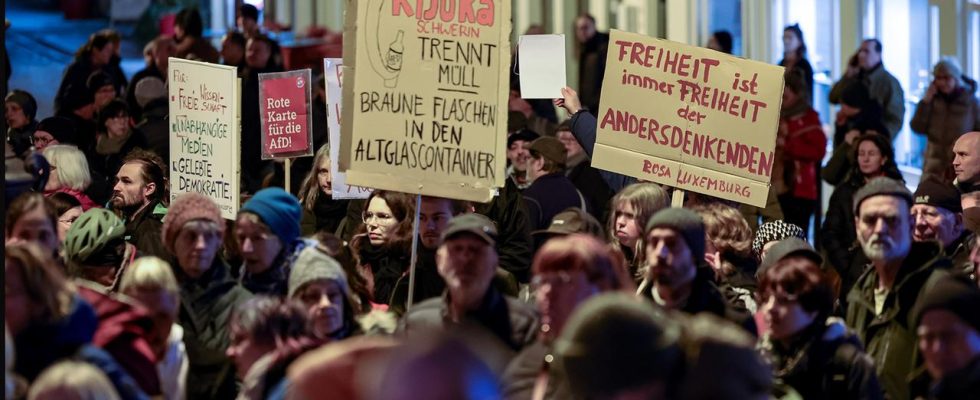Who is taking to the streets against right-wing extremism and why? Researchers at the University of Konstanz examined demonstrations in three cities in more detail. CDU and FDP voters were underrepresented.
Across Germany from the north to the south, from Hamburg, Munich, Stuttgart to Konstanz, people took to the streets against right-wing extremism almost every weekend. In most cases, broad alliances of trade unions, human rights and refugee organizations, associations or even private individuals have called for the demonstrations.
The trigger was research by the Correctiv network in January about a meeting between AfD representatives with neo-Nazis and entrepreneurs, at which the mass expulsion of people with a migration background was discussed. But who exactly are the people who then took to the streets for democracy and against right-wing extremism? What drives them? And what do you think about a possible AfD ban procedure?
Respondents via Random procedure selected
Researchers at the University of Konstanz have examined this in more detail for the Lake Constance region and interviewed more than 500 participants at three demonstrations in Konstanz, Singen and Radolfzell.
The demonstrators were selected using a complex random process, explains sociologist Sebastian Koos from the University of Konstanz. They were counted according to a certain pattern and then addressed.
The entire democratic spectrum was represented at the demonstrations, said Koos. However, with a clear trend.
CDU and FDP voters underrepresented
The researchers found that the majority of the participants surveyed classify themselves politically as center-left, have above-average educational qualifications and have a party preference for the Greens. Voters of the CDU and FDP, however, are underrepresented with a combined share of ten percent.
“CDU and FDP voters often prefer other forms of political participation,” said Koos. The low propensity of this group of voters to protest is also reflected in the researchers’ figures: of the CDU voters surveyed, 80 percent said they had never been to a demonstration or had only been to one in their lives. Among FDP voters it was 62 percent.
Another reason that the CDU and FDP voters in particular are heavily underrepresented: From the perspective of a center-right audience, the line between right-wing extremism and conservatism is sometimes in danger of becoming blurred during the protests. Some middle-class voters might feel placed in the right-wing corner.
It is unclear whether the results are transferable
The survey shows that the lower middle class is also underrepresented. The reason for this is structural barriers, explains Sebastian Koos. “By structural barriers we mean, for example, obligations that one is exposed to in everyday life. So that I cannot take part in a demonstration during the week because I have to work or have to pick up my children from daycare.” Especially in the lower middle class, for example, there is shift work and less flexibility in the division of work.
However, the researchers have not yet found out to what extent this spectrum of visitors to the three cities of Konstanz, Radolfzell and Singen can be transferred to the whole of Germany.
Konstanz is a student city, so there were also many students at a large demonstration with more than 14,000 participants. The demonstration took place on Wednesday evening. “Students often get involved and are more flexible with their time,” says Koos.
Many have barely had it so far Protest experience
What their survey also shows: Many of the participants have little or no experience of protest. Most people found out about the demonstrations through their personal environment. The motivation to actually go was primarily the Correctiv research and the AfD’s high poll numbers. The protesters said that, above all, they want to make a statement and draw attention.
However, only less than a third are in favor of a ban on the AfD. The idea of depriving individual AfD politicians of certain basic rights, however, is supported by almost two thirds of those surveyed.
Focus on connecting element
The demonstrations have now become less frequent and, above all, much smaller. The speeches on the stages are often about a wide variety of topics – from speeches against capitalism, the policies of individual parties such as the CDU or FDP, which are criticized, or even the situation in Israel. These are all topics that tend to polarize rather than bring people together.
“The organizers can do their part by highlighting the unifying democratic element of the demonstrations even more clearly,” said Koos. This is also important in view of the question of the extent to which the current commitment can be successfully transferred into a longer-term project.

